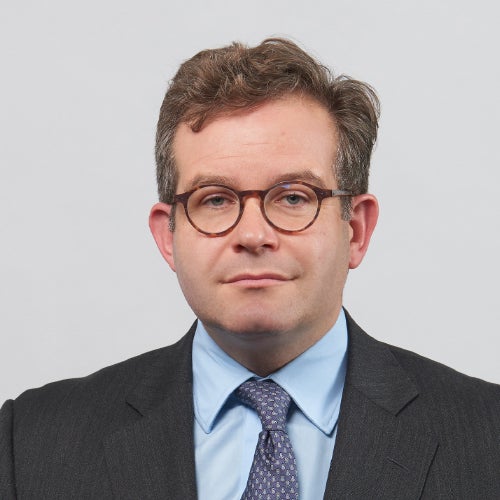Unfiltered views on monetary policy

With rising inflation and interest rate hikes, monetary policy is likely to be top of the agenda for fixed income investors.
We sat down with our fund managers to hear their thoughts.
How are they tackling these challenges in their portfolios? Where do they see opportunity? And is fixed income an attractive place to be? Watch the video.
Transcript
What monetary policy trends do you expect to see play out in 2022 and the coming years?
Gareth Isaac
Well, it’s a fascinating year.
It’s a huge change in dynamic from what we’ve seen over the last couple of years, but actually over the last sort of 10 to 12 years. Since 2008 we’ve been used to unlimited quantitative easing, very low interest rates, falling interest rates, negative interest rates in some places. But now, because of the advent of higher than expected inflation by central banks over the last year or so, we’re starting to see a change in those dynamics.
Thomas Moore
I think progressively higher rates are going to be a feature across all geographies and currencies. Clearly there are some differences in the approach that the major central banks are taking. The US and also the Bank of England have taken, I think, a little bit more of a hawkish stance. But even the ECB, which was fairly dovish on rates until very recently, has started sounding more conservative and hawkish with respect to rates. So I think in the eurozone as well, you’re likely to see rates laddering up, not just in 2022 but 2023 and perhaps even 2024.
You’ve touched briefly on inflation – a topic on every fixed income investor’s mind. Do you foresee that inflation being persistent, or more transitory?
Lyndon Man
Now, obviously recent inflation numbers have been coming in higher than expected, and this has led central banks to pivot more hawkishly. Now, our view is that this was more of a risk management-type exercise to enable central banks to, if you will, assert their inflation fighting credentials and manage, potentially, second-round inflation effects becoming more embedded in terms of longer-run inflation expectations. Now, that being said, we do expect inflation to peak in Q1 this year, but remain relatively high in the first half of the year due to the impact of supply shocks.
Gareth Isaac
Well, there are two camps, aren’t there? One is transient. One is camp persistent. I do think that there is an elevated level of inflation in the global economy, and that may be to do with opening effects, rebounding effects from COVID. It may be to do with supply bottlenecks from increased energy prices. But certainly there does seem to be an elevated underlying level of inflation. I think that’s what’s got central banks a little bit worried, which is why you’ve seen the Federal Reserve change tack so dramatically over the last six months. They’re now pricing in maybe six or seven rate hikes. The Bank of England have raised interest rates. So while we do think inflation will come down from what are persistently high levels, we don’t think we’re likely to see them back down to the levels that we saw over the last two to three years.
So, against this backdrop, how are you positioning?
Thomas Moore
We’re very fortunate in running a series of mandates that are relatively less benchmark-oriented, and which give us a degree of flexibility around how we allocate assets within our portfolios. So we’ve been able to be quite flexible with respect to our duration positioning and have kept the portfolios relatively at the shorter end of the spectrum, in anticipation of higher rates. We also run a lot of funds where you can balance your allocations among different subcategories of fixed income and so, where it’s been useful, for instance, to pursue higher yields as another hedge against higher rates, we’ve been able to do that. I think we’re a little bit less concerned about credit quality at the moment. Not to say that we’re stretching for yield but, in 2022, at any rate, we’re a little bit less concerned about defaults. I think that you might see an upward bias in credit quality as rates rise and as the trade-off between duration and income becomes a little bit less clear than it is now.
Gareth Isaac
Well, in terms of what we have done to try and mitigate some of these pressures, we have a short-duration exposure in the US. We think that the front end of the market especially is mispriced. That has risen, so if you look at the one-year rate in the US, that’s risen to about 2%. The terminal rate, even though you’ve had the front-end move, is still only pricing in a sort of 2% peak in interest rates. We think that could push forward at 2.5, maybe 2.75 in an overshoot, so we’re underweight that particular part of the market. We’ve also reduced some of our risk exposure to things like investment grade and high yield, just on a tactical basis. We think that they will be very attractive once rates rise in the second half of the year, and we also have reduced our general level of risk in portfolios and added some hedges in to protect from a more volatile risk environment.
Are you observing any opportunities in markets?
Paul Syms
The recent pick-up in volatility has actually brought yields back to more attractive levels. We saw, moving into the year-end and into January, yields on government bonds have been rising, anticipating interest rate hikes from central banks. That’s pushed yields back to close to pre-COVID levels in many markets. In addition, the risk-off tone caused by the recent geopolitical tensions has caused spreads to widen, and that has actually made credit markets look slightly more attractive to those investors that want to take on a little bit more risk. So, at this moment in time, fixed income is looking more attractive than it was in the middle of last year, and investors may want to look at this as an opportunity to increase either duration or credit risk, or potentially both.
Gareth Isaac
So we still like emerging markets, even though it’s been quite a volatile period for those. Emerging markets tend to underperform as the Fed are raising interest rates, and we’re going through that process now. But ultimately I do think where valuations are in both hard currency and in some local markets as well – those valuations are quite compelling when you see where interest rates and bond yields are in places like Japan and Europe, and to a certain extent in the US, so we still like emerging markets. We think they offer value, even though the path is probably likely to be quite choppy. We’re happy to add to those in the second half of the year, as I said, once the Federal Reserve full rate hike cycle is priced into the market.
And what about risks? For example, what would be the worst-case scenario in terms of central bank policy?
Thomas Moore
I suppose it would be overreach by central bankers and overshoot in terms of policy adjustment that’s poorly communicated to the market. What we’ve got right now is a generation of central bankers who are certainly conscious of the impact that their words can have on asset prices and on market volatility, but some of the lead governors aren’t as seasoned as you might like and have certainly shown themselves to be capable of poor communication to the markets. So the worst-case scenario would be an excessive hiking of rates that markets don’t anticipate and that leads to real damage to portfolio valuations.
Gareth Isaac
I think that after 14 years of QE and over $25 trillion of bond purchases across all the major central banks, that coming to an end and even going into reverse is going to have profound implications, I think. Many markets have been buoyed by what has been free and easy money over the last, as I said, 14 years, and I do think that there will be unintended consequences to that. As we’ve seen more rate hikes priced into the US and across other major central banks, we’ve started to see corporate bonds and high yield come under pressure, and some emerging markets as well, and I do think that probably has further to run. We think that the US probably needs to price in maybe another 50 basis points to increase the terminal rate, and we do think that transitional period could be quite disruptive for risk markets. But I think in the second half of the year, things should calm down.
So, we’ve focused a little on how active fund managers can flex their allocations to navigate changing market environments. Paul, what can investors look for in the ETF space?
Paul Syms
The way I’d look at fixed income ETFs is that they provide end investors the choice, rather than relying on an active manager to make certain decisions for them. So, for example, if an investor wants to take on more credit risk, they can do so through certain specific ETFs, or, likewise, they could use ETFs to adjust duration. There’s normally a choice of different maturity buckets, so investors could use the different maturity buckets to either increase or reduce the overall interest rate risk of their portfolios.
And, in the context of the monetary policy changes we’ve seen, what are ETF investors likely to be looking for?
![]() Paul Syms
Paul Syms
To combat tighter monetary policy, investors are likely to take on board more credit risk than interest rate risk. We have a range of lower-duration and higher-yielding products within the ETF range, which offer investors exposure to subordinated debt. That is to say that you’re getting a higher yield through subordination within the capital structure, rather than actually taking on board exposure to riskier issuers.
We’re entering a period of rising rates, which can make things challenging. Is fixed income an attractive place to be?
Gareth Isaac
I think fixed income is an attractive place to invest on a number of key issues. I think that, despite our expectations that the interest rates are going to rise, we still think they’re going to remain relatively low compared to historical standards, so we don’t see a sharp increase in interest rates. We just see a gradual increase in interest rates, but to levels where they have been previously. So investors will still be looking for an attractive income. That’s not going to be available from bank accounts, for example, so investors will still be looking for fixed income to provide that.
Thomas Moore
Clearly, even in an environment of rising rates, income in the world that we’re living in is very hard to come by, and so a fixed income portfolio, especially one where you have flexibility to allocate among different subclasses of fixed income, I think is a big part of any investor’s overall strategy in terms of generating the kind of income that you need to achieve all sorts of financial goals.
Although the negative correlation between government bonds and stocks has broken down over recent years, I think that, were we to enter a more normal rate environment, say over the next couple of years, that traditional hedge would reassert itself and maybe put investors back into the position that they were traditionally in pre-GFC, where they thought of the bond portion of their portfolio as an offset to whatever was happening on the equity side.
Listen to the podcast
Prefer to listen to our views on the go? We’ve also recorded a podcast version of the interview.
- [00:08] Introducing the monetary policy backdrop
- [00:53] Outlook for 2022 and beyond
- [02:09] Inflation, inflation, inflation…
- [03:44] Portfolio positioning
- [05:59] Market opportunities
- [07:43] Worst case scenarios: what are the big risks?
- [09:25] What can ETFs offer?
- [10:30] In a rising rate environment, is fixed income an attractive place to be?
Related insights
Markets are constantly evolving. Read the latest pieces from our investment experts and thought leaders, including commentary on the evolving Russia-Ukraine crisis.
Discover (un)fixed income
We know investors are living through an unprecedented period of market disruption and volatility. As we face these new realities, we think taking an unfixed approach to fixed income is an advantage.
From active to passive, from mainstream to innovative, we have the expertise, the strategies and the flexibility needed to match your objectives as markets evolve.
Investment risks
-
The value of investments and any income will fluctuate (this may partly be the result of exchange rate fluctuations) and investors may not get back the full amount invested.
Important information
-
This is marketing material and not intended as a recommendation to buy or sell any particular asset class, security or strategy. Regulatory requirements that require impartiality of investment/investment strategy recommendations are therefore not applicable nor are any prohibitions to trade before publication.
Where individuals or the business have expressed opinions, they are based on current market conditions, they may differ from those of other investment professionals, they are subject to change without notice and are not to be construed as investment advice.





